The Climate-Positive Benefits of Concrete in Outdoor Architecture
Learning Objectives:
- Discuss the need to reduce carbon and other greenhouse gases in the atmosphere.
- Describe the manufacture of concrete, its use worldwide, and technological advances.
- Identify climate-positive outdoor design.
- Define the impact of material choices in outdoor architecture.
- Describe climate-positive projects where concrete plays a critical role.
Credits:
This course is approved as a Structured Course
This course can be self-reported to the AANB, as per their CE Guidelines
Approved for structured learning
Approved for Core Learning
This course can be self-reported to the NLAA
Course may qualify for Learning Hours with NWTAA
Course eligible for OAA Learning Hours
This course is approved as a core course
This course can be self-reported for Learning Units to the Architectural Institute of British Columbia
Outdoor architecture has a vital role to play in the coming years to achieve net zero and carbon negative in the built environment, and it requires a more in-depth consideration of durable materials and their proper use. The resilience of concrete in outdoor design is well known. Still, more understanding is needed about modern concrete, the savvy use of this impressive material, and its actual impact on the environment. Specifying permeable pavers is an excellent example of an intelligent design strategy that decreases material use but increases environmental benefits. This course takes a deep dive into the use of concrete in outdoor architecture to benefit people and the planet.
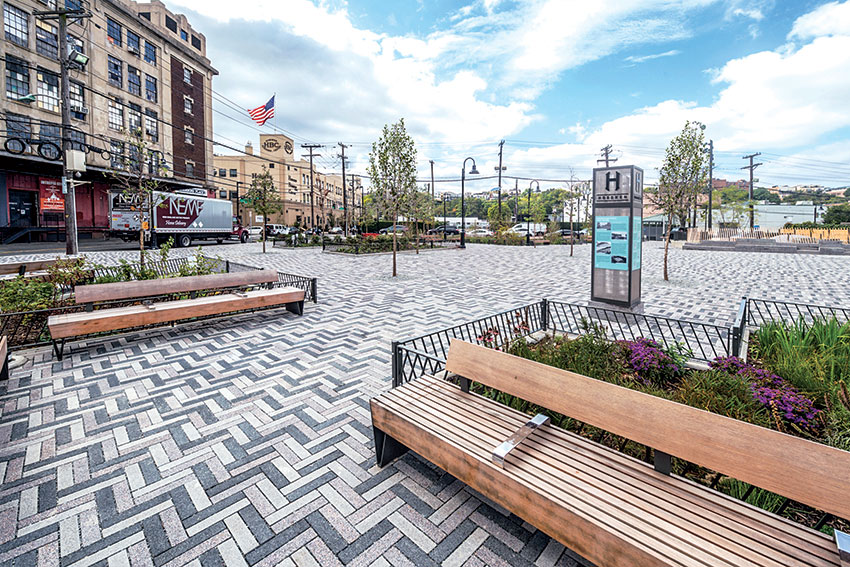
Photo courtesy of Unilock
Aesthetically pleasing and durable, permeable pavers help prevent flooding in parks, plazas, and other outdoor spaces.
HOW OUTDOOR ARCHITECTURE HELPS MEET SUSTAINABILITY GOALS
Within the design/build industry, architects and designers have long taken the lead toward creating a sustainable future. That is true for the creation of indoor spaces and outdoor spaces alike. “As a firm, we strive to leave our world better than we found it,” says Hana Ishikawa, design principal with Site Design in Chicago. Toward that goal, the firm has designed several pocket parks with permeable surfaces that help collect rainwater to prevent street flooding and also fill underground aquifers. “As the topic of global warming becomes an increasingly important discussion,” Ishikawa adds, “permeability in our hard walking surfaces becomes increasingly important.”
The New York City Department of Parks & Recreation (NYC Parks) has the same focus.
“Planning for the long-term resiliency of our open spaces is a primary objective of NYC Parks,” says NYC Parks Press Officer Gregg McQueen. “The use of permeable pavers has proved to be an effective means of managing stormwater, reducing the environmental impact of paved spaces and helping Parks create a more sustainable and resilient city.”
Resiliency in Hoboken, New Jersey
A prime model of beneficial outdoor architecture is Southwest Resiliency Park, located in a chronically flooded, formerly industrial, lowland district in Hoboken, New Jersey, along the Hudson River. Today there lies a jewel of a one-acre pocket park that is as functional below ground as fantastical above ground. The popular park, built in 2017, features a dog run, restroom, pop-up market space, amphitheater, open lawn, and playground space to promote year-round social activity. This is evidenced by kids running and playing, people reading, visiting each other, and dogs playing.

Photo courtesy of Unilock
The durability of permeable pavers helped achieve the designers’ goals for the Southwest Resiliency Park in Hoboken, New Jersey.
The heart of the space is an open area paved with eye-catching open-jointed concrete pavers, also known as permeable pavers, which give the site a high-quality aesthetic that is both sophisticated and lively. But the real beauty of the park is its role in Hoboken’s water management strategy to delay, store, and discharge stormwater that, during extreme rain events, has overwhelmed the combined sewer system and flooded low-lying areas in the neighborhood.
The various layers of the system—seen and unseen—include the open-jointed permeable pavers, tree cells with aerated soil to collect water, rain gardens, and street bioswales. These systems lead to the subsurface detention area that can store up to 200,000 gallons of water from significant storm events. This park sets a new standard for integrating urban public space with storm protection.
It’s hard to see how this resilience-focused project could have been accomplished without one of the most resilient materials on Earth—concrete. Permeable concrete pavers to help prevent flooding have been used in parking lots where giant yellow buses drop off and pick up school kids, as well as in shipping ports where heavy tractor-trailers roll up to pick up loads of cargo. Even when concrete's strength and versatility are acknowledged, the question remains: What about carbon emissions?
“For designers working on projects with specific carbon targets, the evaluation and material selection process is complex,” says Elaine Willis, Director of Sustainability at Unilock. “It isn’t as simple as selecting products with low or zero embodied carbon, but understanding how the product will work in situ to create a system that provides multiple environmental benefits, including reducing and sequestering embodied carbon from the environment.” Willis continues: “We are seeing innovations across the whole spectrum of the concrete industry, from alternate cementitious materials to efficiencies in the manufacturing processes, in our facilities, and in our suppliers. It will be the culmination of all efforts that will get us to net zero.”
CONCRETE AND CARBON EMISSIONS
When designing for a sustainable future, the goal of net-zero carbon emissions is typically front and center as a concern. “Working toward net-zero carbon emissions requires designers to place a magnifying glass over all materials and operations,” says landscape architect Misa Inoue, PLA, ASLA, and project designer Jason Vogel, LEED AP BD+C, both with Ross Barney Architects. They worked on the McDonald’s Chicago Flagship Restaurant, which will be discussed later in the course.
Much has been written about the amount of concrete used worldwide and its associated carbon emissions. But these statistics need more context. Rarely is concrete's incomparable strength and durability factored into the discussion. Many would be surprised to learn that carbon emissions associated with concrete are less than even educated people realize.
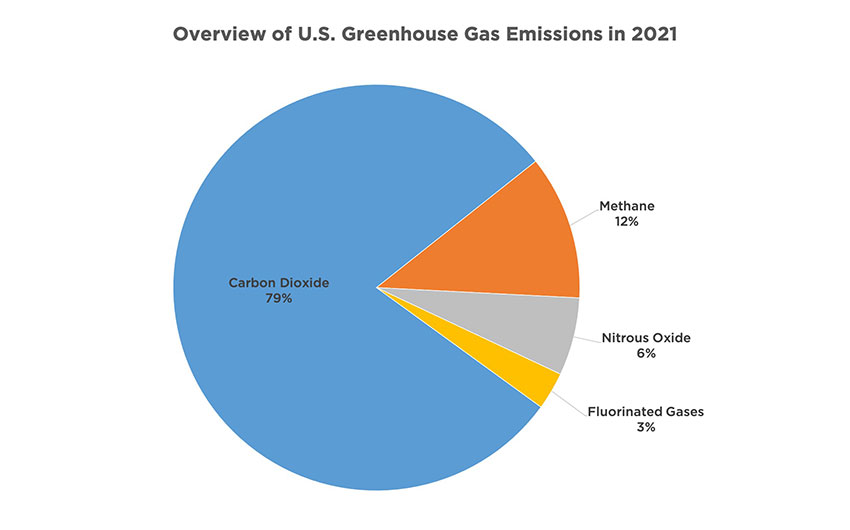
Image courtesy of Unilock; Source: “Overview of Greenhouse Gases”
The comparative percentage of gases in the atmosphere.
The Need to Reduce Carbon and Other Greenhouse Gases in the Atmosphere
The Earth’s atmosphere relies on a balance of greenhouse gases (GHG) to reflect heat from the sun, allowing some heat to escape and retaining what flora and fauna (including humans) need for a comfortable, habitable planet. The past century has seen advances in modern society, such as motorized vehicles, heating and cooling systems for buildings, and manufacturing. All of these traditionally use fossil fuels. Compounded by deforestation and urban development, human activity has created an imbalance in the GHG, primary carbon dioxide (CO2). This has resulted in a global temperature rise and significant weather events.
“Embodied carbon” is the globally chosen value to measure the movement toward a net- zero environment. The definition of embodied carbon is the carbon dioxide equivalent relative to the global warming potential (GWP). Therefore, embodied carbon and GWP are often used interchangeably. For structural materials, embodied carbon is linked to the extraction of the raw material, manufacturing, transportation, construction, maintenance during service life, demolition, and end of life. This measurement allows designers to manage choices for materials. Hence environmental product declarations (EPDs) are created for products, leading to more informed product and design decisions. However, a simple number only tells part of the story.
Other Gases in the Earth’s Atmosphere
Before discussing the building materials and environments, it is essential to understand how carbon dioxide stacks up against the other elements that make up the atmosphere. There is more CO2 in the atmosphere than other gases, but those other gases have a much more significant effect in smaller quantities.
Methane: According to the Environmental Protection Agency1, one pound of methane has a 25 times greater negative effect over 100 years than one pound of CO2. The typical sources of methane in the environment are from agriculture, natural gas, petroleum systems, and landfills.
Nitrous oxide: One pound of nitrous oxide has the same global warming effect as 22 pounds of carbon dioxide in the atmosphere. The majority of that is from agricultural soil management.
Fluorinated gases: Fluorinated gases (gases that were created to replace chlorofluorocarbons) and hydrochlorofluorocarbons (which are old refrigerants used in building and vehicular air conditioning systems) have a high global warming potential and stay in the atmosphere for thousands of years. These are released during manufacturing processes, leaks, servicing, and equipment disposal. A new subset of HFCs is being developed with short atmospheric lifetimes and lower GWPs.
Embodied Carbon vs. Operational Carbon
The built world accounts for 37 percent of global emissions. Building materials and construction equals 9 percent, including renovations and new builds, while 28 percent is caused by building operations. The most significant source of human-generated CO2 emissions is fossil fuel power plants, at 36 percent in the chart. In the U.S., passenger vehicles and light trucks generate another 20 percent, while this value is 22 percent globally.
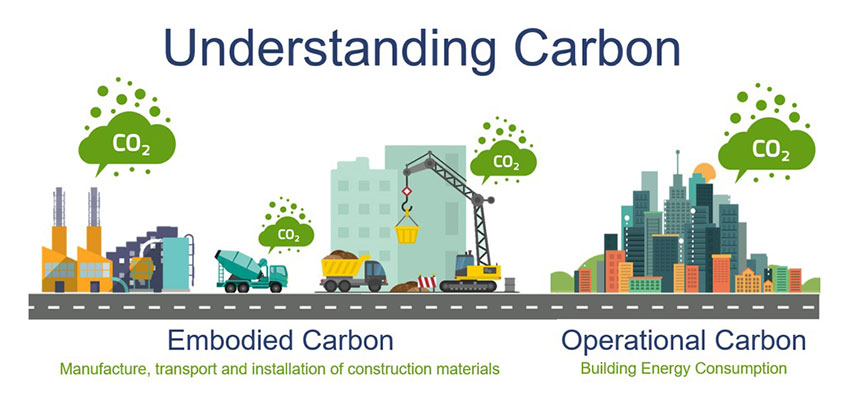
Image courtesy of Stacy Smedley, SKANSKA/CLF
There is a difference between embodied carbon and operational carbon.
Globally, cement accounts for 7 percent of emissions, primarily due to the intensive process of extracting and creating this material with the characteristics required by the built environment. Though well below the emissions of agriculture, power, and transportation, this quantity is not insignificant. It is also important to note that cement manufacturing accounts for less than 1.5 percent of all U.S. human-generated CO2, according to the Portland Cement Association.2
Over the last century, the cement industry has reduced carbon dioxide emissions per ton, but production is growing substantially worldwide due to economic growth, notably in developing countries. Compounding this issue is the shorter life cycle of concrete buildings in China, increasing the need for cement. In North America, the lifecycle of a building averages 60 years. However, in China, the average lifecycle of a building averages only 35 years. According to the Journal of Cleaner Production, “China has about 60 billion m2 of existing buildings, with approximately 2 billion m2 newly constructed each year. This accounts for half of all new buildings globally.”3
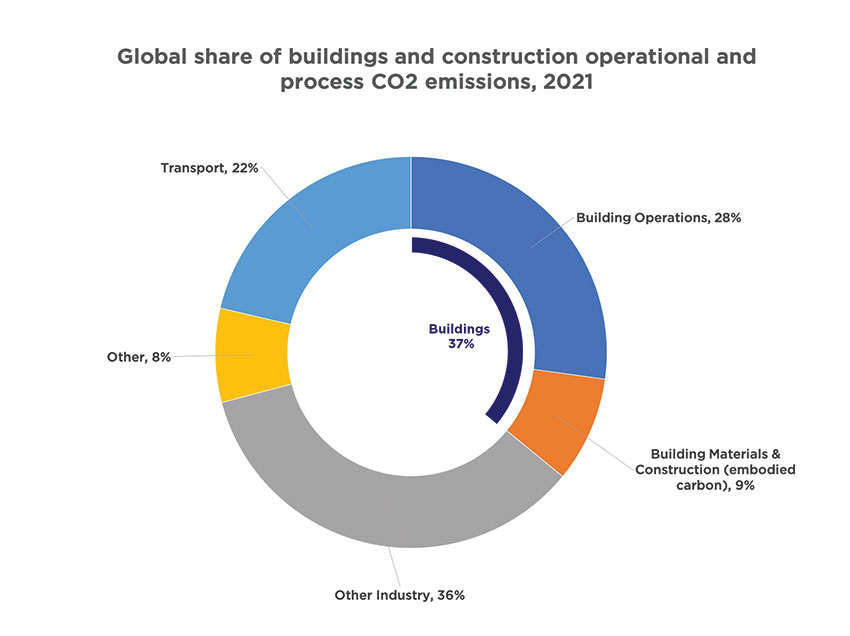
Annual global emissions by source.
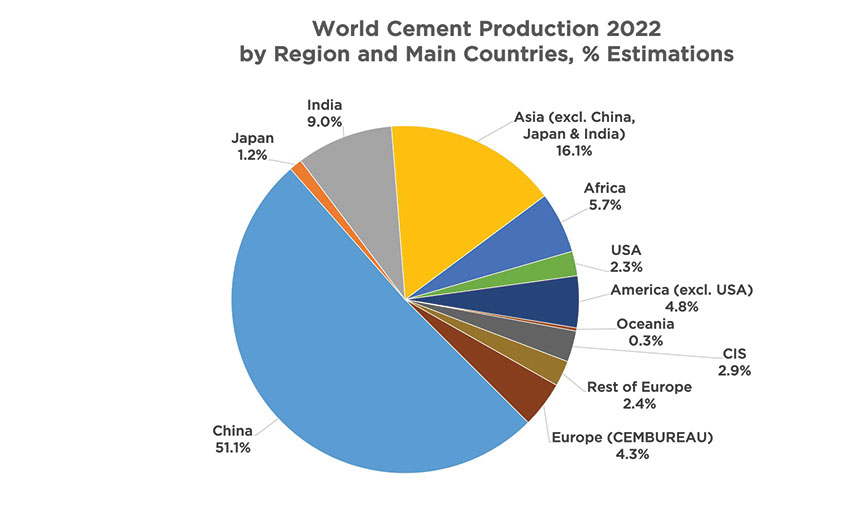
Image courtesy of Unilock. Source: World Cement Production 2022
China’s use of concrete far exceeds that of other countries.

















